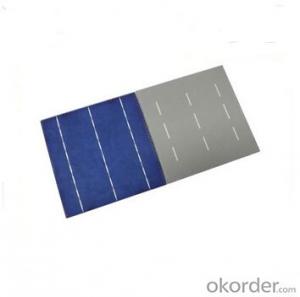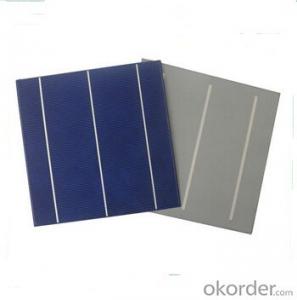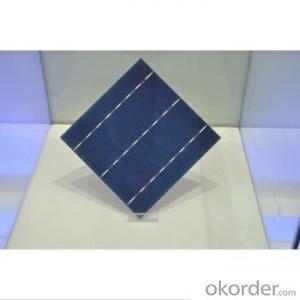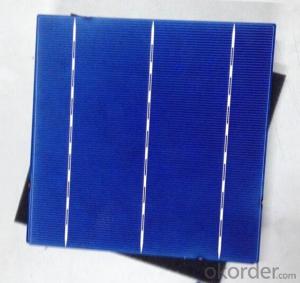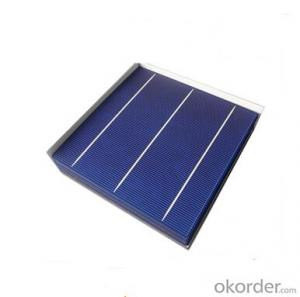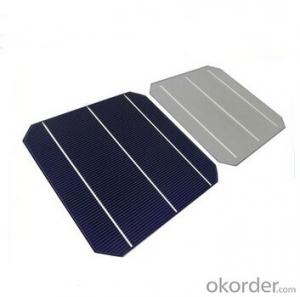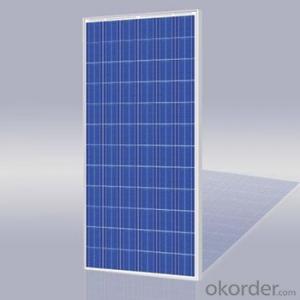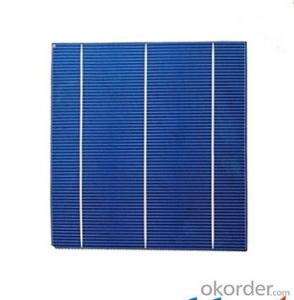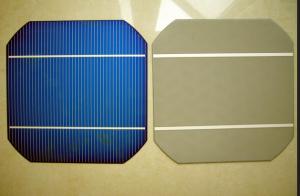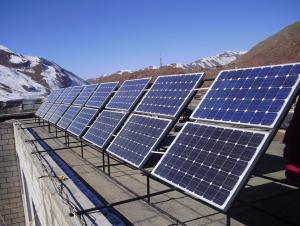High Quality Cigs Thin Film Solar Cells - Polycrystalline Solar Cells
- Loading Port:
- Shanghai
- Payment Terms:
- TT OR LC
- Min Order Qty:
- 1000 pc
- Supply Capability:
- 1000000 pc/month
OKorder Service Pledge
OKorder Financial Service
You Might Also Like
PolyCrystalline Silicon Solar Cell 3 Bus Bars Alkaline:
Solar cells is made by solar wafer, it has three categories of solar cell right now, monocrystalline polycrystalline and thin film,These cells are entirely based around the concept PN junction, which is the critical part of solar module, it is the part that can convert the light energy into electricity, the thickness is from 180um to 200um, with even busbars to conduct electricity, textured cell can decrease diffuse reflection; they are often electrically connected and encapsulated as a module. Photovoltaic modules often have a sheet of glass on the front (sun up) side, allowing light to pass while protecting semiconductor wafers from abrasion and impact due to wind-driven debris, rain, hail, etc. Solar cells are also usually connected in series in modules, creating an additive voltage. Connecting cells in parallel will yield a higher current;With high quality and stable quality. Our Cells can greatly improve the performance of Solar Modules.
PolyCrystalline Silicon Solar Cell 3 Bus Bars Alkaline Advantage:
• High efficiency and stable performance in photovoltaic conversion.
• Advanced diffusion technique ensuring the homogeneity of energy conversion efficiency of the cell.
• Advanced PECVD film forming, providing a dark blue silicon nitride anti-reflection film of homogenous color and attractive appearance.
• High quality metal paste for back surface and electrode, ensuring good conductivity, high pulling strength and ease of soldering.
• High precision patterning using screen printing, ensuring accurate busbar location for ease with automatic soldering a laser cutting.
Specifications:
Model | Efficiency | Power | Max Power Current | Min Power Current | Max Power Voltage | Short Circuit Current | Open Circuit Voltage |
Eff(%) | Ppm(W) | Ipm(A) | Ipm(A) | Vpm(V) | Isc(A) | Voc(V) | |
C-156P | 17.80-17.99 | 3.89 | 7.50 | 7.38 | 0.527 | 8.04 | 0.630 |
C-156P | 17.60-17.79 | 3.84 | 7.45 | 7.32 | 0.525 | 7.94 | 0.628 |
C-156P | 17.40-17.59 | 3.80 | 7.40 | 7.25 | 0.523 | 7.90 | 0.629 |
C-156P | 17.20-17.39 | 3.76 | 7.35 | 7.17 | 0.518 | 7.86 | 0.628 |
C-156P | 17.00-17.19 | 3.71 | 7.3 | 7.10 | 0.516 | 7.80 | 0.625 |
C-156P | 16.80-16.99 | 3.67 | 7.25 | 7.05 | 0.514 | 7.75 | 0.623 |
C-156P | 16.60-16.79 | 3.63 | 7.20 | 6.98 | 0.512 | 7.70 | 0.620 |
C-156P | 16.40-16.59 | 3.58 | 7.15 | 6.90 | 0.510 | 7.64 | 0.618 |
C-156P | 16.20-16.39 | 3.54 | 7.1 | 6.72 | 0.508 | 7.57 | 0.616 |
C-156P | 16.00-16.29 | 3.49 | 7.05 | 6.56 | 0.506 | 7.35 | 0.614 |

Packaging & Delivery of Polycrystalline Solar Cells
Carton Box Package and Deliver by air. It should be noticed that it should be avoid of water, sunshine and moist.
FAQ
We have organized several common questions for our clients,may help you sincerely:
①What price for each watt?
It depends on the efficiency of the solar cell, quantity, delivery date and payment terms.
②How long can we receive the product after purchase?
In the purchase of product within three working days, We will arrange the factory delivery as soon as possible. The pecific time of receiving is related to the state and position of customers.Commonly 7 to 10 working days can be served.
③Can you provide the peripheral products of the solar panels, such as the battery, controller, and inverter? If so, can you tell me how do they match each other?
Yes, we can, we have two companies for solar region, one is CNBM International, the other is CNBM engineering Co.
We can provide you not only the solar module but also the off grid solar system, we can also provide you service with on grid plant.
④What is your warranty of solar cell?
Our product can promise lower than 0.3% open box crack, we support claim after opening the box if it has crackm color difference or sth, the buyer should give pictures immediately, we can not accept the claim after the solar cell has assembled to solar panel.
• Timeliness of delivery
• ⑤How do you pack your products?
We have rich experience on how to pack the solar cell to make sure the safety on shipment, we could use wooden box or pallet as buyer's preference.
⑥ Can you do OEM for us?
Yes, we can.
- Q: How do solar cells perform in areas with frequent earthquakes?
- Solar cells can perform well in areas with frequent earthquakes, as they are designed to withstand a certain level of structural stress. However, the installation and mounting of solar panels should be done with proper engineering considerations to ensure their stability during seismic events. Additionally, regular inspections and maintenance may be required to address any potential damages caused by earthquakes.
- Q: Can solar cells be used in recreational vehicles?
- Yes, solar cells can be used in recreational vehicles. Installing solar panels on RVs allows them to harness the power of the sun to generate electricity, which can be used to charge batteries and power appliances while on the road. This helps to reduce reliance on traditional power sources, making RVs more energy-efficient and environmentally friendly.
- Q: Can solar cells be used in agriculture for irrigation?
- Yes, solar cells can be used in agriculture for irrigation. Solar-powered irrigation systems can efficiently harness solar energy to pump water from wells, rivers, or other sources, reducing the dependency on fossil fuels and electricity. This sustainable solution can help farmers irrigate their fields and crops, especially in remote areas with limited access to electricity grids.
- Q: What is the payback period for solar cells?
- The payback period for solar cells refers to the amount of time it takes for the cost of installing and maintaining solar cells to be recouped through the savings generated from reduced or eliminated electricity bills. Typically, the payback period for solar cells ranges from 5 to 10 years, depending on factors such as installation cost, energy consumption, government incentives, and regional sunlight availability.
- Q: Can solar cells be used in military applications?
- Yes, solar cells can be used in military applications. They can provide a reliable and sustainable source of power for various military equipment and operations, such as powering communication systems, surveillance devices, and remote military outposts. Solar cells offer the advantage of being lightweight, portable, and environmentally friendly, making them well-suited for military use in remote or off-grid locations. Additionally, solar power reduces the dependence on traditional fuel sources, minimizing logistics challenges and enhancing operational effectiveness.
- Q: Can solar cells be installed on any type of roof?
- Yes, solar cells can be installed on almost any type of roof, including flat roofs, sloped roofs, metal roofs, tile roofs, and even asphalt shingle roofs. However, the specific installation process may vary depending on the type of roof and its structural integrity. It is always recommended to consult with a professional solar installer to assess the feasibility of installation on a particular roof type.
- Q: Can solar cells be used for powering navigation buoys?
- Yes, solar cells can be used for powering navigation buoys. Solar cells are a reliable and sustainable source of energy that can generate electricity from sunlight, making them ideal for remote locations such as navigation buoys. They can effectively power the lighting and other electrical systems on the buoys, eliminating the need for traditional power sources and reducing maintenance costs.
- Q: How do solar cells perform in areas with high levels of air pollution?
- Solar cells can experience a decrease in performance in areas with high levels of air pollution due to reduced sunlight reaching the surface of the cells. The presence of pollutants in the atmosphere can block or scatter sunlight, leading to a decrease in the amount of energy that can be converted by the solar cells.
- Q: Can solar cells be used in disaster response vehicles?
- Yes, solar cells can be used in disaster response vehicles. They can help power the vehicle's electrical systems and equipment, providing a sustainable and reliable source of energy in emergency situations where traditional power sources may be unavailable or unreliable. Additionally, solar cells can reduce the dependence on fossil fuels and contribute to a more environmentally friendly response effort.
- Q: What is the impact of wind on solar cell performance?
- The impact of wind on solar cell performance can be both positive and negative. On one hand, wind can help to cool down the solar panels, preventing them from overheating and maintaining their efficiency. Additionally, a gentle breeze can help to disperse any accumulated dust or debris on the panels, ensuring maximum sunlight absorption. On the other hand, strong winds can create vibrations that may damage the solar panels or the mounting structure, leading to potential performance degradation or even system failure. Therefore, while some wind can be beneficial, it is important to properly design and install solar panels to withstand and minimize any negative impact from strong winds.
Send your message to us
High Quality Cigs Thin Film Solar Cells - Polycrystalline Solar Cells
- Loading Port:
- Shanghai
- Payment Terms:
- TT OR LC
- Min Order Qty:
- 1000 pc
- Supply Capability:
- 1000000 pc/month
OKorder Service Pledge
OKorder Financial Service
Similar products
Hot products
Hot Searches
Related keywords
